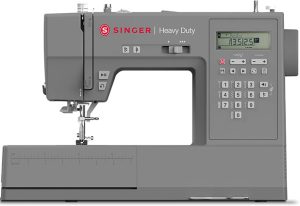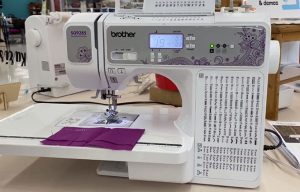Sewing machines have come a long way since their inception, evolving from the manual treadle models of yesteryears to today’s advanced electronic and computerized versions.
As sewing technology continues to advance, the line between electronic sewing machines and computerized sewing machines gets blurrier, making it a challenge for beginners and enthusiasts alike to choose between them.
This article will delve into the nuances of these two types of machines, comparing their features, benefits, and suitability for different sewing needs.
Electronic vs Computerized Sewing Machines
Comparison Table:
The Basic and Advanced Difference Between Electronic and Computerized Sewing Machines…
| Category | Electronic Sewing Machines | Computerized Sewing Machines |
|---|---|---|
| Images |  |  |
| Functionality | Powered by electricity. Offers manual control with electronic assistance. | Uses electricity with a built-in microcomputer for automated processes. |
| Stitch Selection | Dial or buttons for limited pre-set patterns. | LCD or touch screen with vast stitch options. |
| Price | Generally more budget-friendly. | Pricier due to advanced features. |
| Customization & Memory | Limited to no capability for saving custom settings. | Can save and retrieve stitch sequences or settings. |
| Connectivity | No connectivity options. | Some can connect to the internet or devices for updates and patterns. |
| Advanced Features | Limited features like automatic buttonholing. | Features like automatic threading Computerized Sewing Machine, embroidery, tension control, etc. |
| Maintenance | Straightforward, fewer software updates. | Mechanical maintenance plus occasional software updates. |
| Learning Curve | Easier for beginners, fewer features to navigate. | Might be steeper for those not tech-savvy due to advanced functionalities. |
Pros and Cons
Pros: Electronic Sewing Machines
- Affordability: Generally, electronic sewing machines are more budget-friendly, making them accessible to a wider range of users.
- Durability: Often built with fewer complex parts, electronic machines tend to be robust and can have a longer lifespan with proper care.
- Simplicity: For those who just want to sew without fuss, electronic machines provide straightforward operations. They’re particularly great for basic projects where advanced features aren’t required.
Cons: Electronic Sewing Machines
- Limited Stitch Options: While they might offer a range of stitches, it’s usually limited compared to their computerized counterparts.
- Fewer Advanced Features: Most electronic machines won’t have the bells and whistles of the computerized versions. Think of features like automatic tension control or detailed embroidery – they’re often missing here.
Pros: Computerized Sewing Machines
- Vast Stitch Options: With a microcomputer inside, these machines can store a wide array of stitch patterns. This versatility allows for more creative and intricate sewing projects.
- Advanced Features: Beyond just stitches, computerized machines often come with features like auto-threading, auto-cutting, and even built-in embroidery designs.
- Customizable Stitch Patterns: Some models allow users to design their own stitch patterns or download new designs, offering a higher level of customization.
Cons: Computerized Sewing Machines
- Price: All these advanced features come at a cost. Computerized sewing machines are generally more expensive, which can be a barrier for some.
- Learning Curve: With more features comes more complexity. Beginners might find it overwhelming to navigate through all the functions of a computerized machine.
- Maintenance: These machines may require more frequent maintenance, both in terms of hardware and software, to keep them running smoothly.
In summary, electronic sewing machines are great for those who want a reliable, straightforward machine without breaking the bank. In contrast, computerized sewing machines cater to those who desire advanced features, and versatility, and are willing to invest both money and time to master their use. Your choice should align with your sewing aspirations and budget.
Related: What is the Difference Between a Computerized and Mechanical Sewing Machine
Which is Better: Electronic vs. Computerized Sewing Machines?
Choosing between an electronic and computerized sewing machine depends on individual needs. For basic sewing needs, electronic machines suffice. However, for those looking to delve into intricate projects and desire advanced features, a computerized machine would be a better choice.
The answer to this isn’t a one-size-fits-all solution. It’s akin to comparing a basic phone to a smartphone: both have their purposes and what might be better for one person could be less ideal for another. Here are some factors to consider:
Your Sewing Goals:
- Casual or Basic Projects: If you’re sewing occasionally, maybe doing some repairs, or simple projects like curtains or pillow covers, an electronic machine might be all you need.
- Advanced or Professional Sewing: If you’re diving into intricate designs, quilting, or embroidery, or if sewing is more than just a hobby for you, a computerized machine with its advanced capabilities could be a boon.

Budget:
- Cost-Conscious: If you’re on a tight budget or just starting, electronic sewing machines are generally less expensive and give a decent bang for your buck.
- Ready to Invest: If you’re willing to invest in a feature-rich experience and see sewing as a long-term passion or profession, spending more on a computerized machine might be worthwhile.

Ease of Use & Learning Curve:
- Beginners: Those new to sewing might appreciate the simplicity of electronic machines. Without too many bells and whistles, it’s easier to focus on mastering the basics.
- Tech-Savvy or Experienced Sewers: If you’re comfortable with technology or have prior sewing experience, navigating a computerized machine’s features might not be daunting and can even be exciting.
Maintenance & Longevity:
- Low Maintenance: Electronic machines, with their fewer components, typically require less frequent upkeep.
- Regular Updates: Computerized machines might require both hardware maintenance and software updates. They might offer more years of service with the right care but can also become outdated if technology outpaces the machine’s capabilities.
Customization & Growth:
- Fixed Features: With electronic machines, what you buy is generally what you get in terms of features.
- Expandability: Computerized machines often allow for downloading new stitch patterns or updating features, making them adaptable to evolving sewing trends.
However, the better machine is the one that aligns with your needs, experience, and budget. If you want reliability without complexity, an electronic machine might be your ally. But if you’re aiming for versatility and advanced features, and you’re prepared for a steeper learning curve, then a computerized machine might be your best companion on your sewing journey.

Suitability for Beginners: computerized sewing machine vs electronic sewing machine
While electronic machines are often recommended for beginners due to their simplicity, many computerized machines today come with user-friendly interfaces that make them equally suitable. It ultimately depends on the learner’s aptitude and the level of complexity they’re comfortable with.
| Criteria | Electronic Machines | Computerized Machines |
|---|---|---|
| Ease of Use | Simple controls: buttons, dials, levers. | Intuitive interfaces, but might have more options. |
| Learning Resources | Ample tutorials due to longer market presence. | Built-in or brand-specific online tutorials are available. |
| Customization | The focus remains on basic stitches and features. | Offers more customization, which can be a double-edged sword for beginners. |
| Price Point | Generally more budget-friendly. | Higher price due to advanced features. |
| Tech Adaptability | Best for those who like tactile controls. | Perfect for tech enthusiasts or those used to digital interfaces. |
| Potential for Growth | Good for basics; might feel limiting as skills progress. | Expansive features allow for growth without needing an upgrade. |
Understanding the Core: What is the difference between a computerized and an electronic sewing machine?
At their essence, both electronic and computerized sewing machines are powered by electricity. However, the primary distinction lies in their operation and features:
- Electronic Sewing Machines: These machines simplify the sewing process by using electricity to assist with tasks that would be manual on purely mechanical machines. They typically have buttons or dials to select stitches and control sewing speed.
- Computerized Sewing Machines: Equipped with a built-in microcomputer, these machines take sewing to a technologically advanced level. They often feature LCD or touchscreen displays, can have numerous stitch patterns, and allow for customization and memory recall of stitches.
Starting Your Sewing Journey: Electronic vs computerized sewing machines for beginners.
Entering the world of sewing can feel overwhelming with the multitude of machine options available. Here’s how the two contenders weigh in for novices:
- Electronic Machines: They offer a more direct, tactile experience with buttons and dials. Their limited features mean beginners can focus on foundational skills without getting distracted by complexities.
- Computerized Machines: Modern computerized machines are designed with user-friendliness in mind. Some offer built-in tutorials and intuitive icons. However, the breadth of features can be a double-edged sword – exciting for some and overwhelming for others.
In essence, beginners should evaluate their tech comfort level, willingness to learn, and budget before opting for a machine.

Our Take:
Electronic vs Computerized Sewing Machines – Why the Distinction Matters?
Diving into the sewing scene? Here’s the rundown. Electronic sewing machines are your straightforward workhorses—simple, dependable, and efficient. On the flip side, computerized sewing machines are the advanced version, boasting a plethora of features for the detail-oriented sewer.
But why should you care about this distinction? Think of it as choosing between a trusty daily commuter and a feature-packed luxury vehicle. Each has its merits, but it boils down to your sewing goals and preferences. It’s about picking the machine that complements your craft. Go with what aligns with your sewing ambitions!
Conclusion
The decision between an electronic and a computerized sewing machine boils down to individual preferences, needs, and budget.
While electronic machines offer durability and simplicity, computerized machines provide advanced features and customization options. Whether you’re a beginner or an expert, it’s crucial to assess your sewing aspirations before making a choice.
FAQs
Q1: What is the difference between a computerized and an electronic sewing machine?
A1: Electronic sewing machines utilize electronic components for basic settings while computerized ones have a microprocessor, offering more advanced features and stitch options.
Q2: Are computerized sewing machines better?
A2: “Better” is subjective. Computerized machines offer more advanced features, but electronic machines are often more durable and simpler to use for basic tasks.
Q3: Which is more suitable for beginners?
A3: Electronic machines are generally simpler and recommended for beginners, but many modern computerized machines have user-friendly interfaces suitable for newcomers as well.
